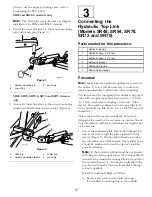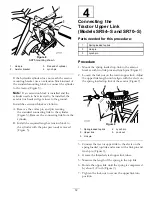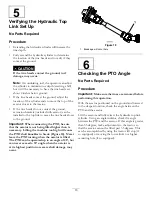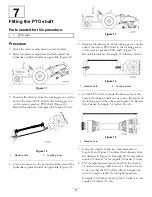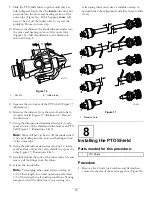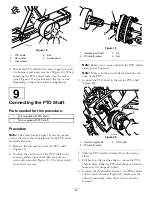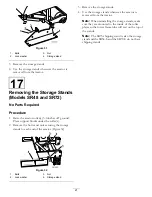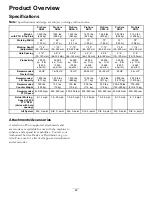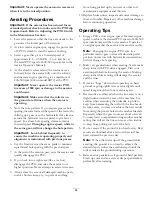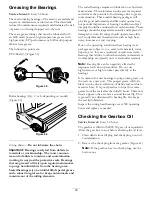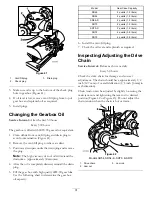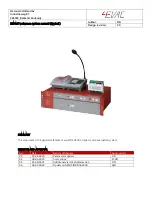
Operation
Note:
Determine the left and right sides of the
machine from the normal operating position.
Tractor Controls
It is necessary to familiarize yourself with the operation
of the following tractor controls before you are able to
operate the aerator:
•
PTO Engagement
•
Engine/PTO Rpm
•
3 Point Hitch (Raise/Lower)
•
Auxiliary Valve Operation
•
Clutch
•
Throttle
•
Gear Selection
•
Parking brake
Note:
Refer to tractor Operator's Manual for
operating instructions.
Principles of Operation
The tractor's three point hitch linkage/hydraulic top
link lifts the aerator for transport and lowers it for
operation.
The tractor's power take off (PTO) power is transmitted
via shafts, gearbox and O-ring drive chains to a
crankshaft which drives the tine holding arms into the
turf surface.
As the tractor travels forward with the PTO engaged
and the machine lowered, a series of holes are created
in the turf surface.
The depth of the tine's penetration is determined by
extending the hydraulic top link or setting the fixed top
link to the desired position.
Note:
Do not attempt to adjust a fixed top link while
the machine is running.
The distance between the holes created is determined
by the tractor's gear ratio (or hydrostatic traction pedal
position) and the number of tines in each tine head.
Simply changing engine rpm does not change hole
spacing.
Tractor PTO Speed
The aerator is designed to operate with a PTO speed
of up to 500 rpm depending on the size/weight of the
tines. Most tractors indicate a 540 PTO rpm position
on the rev counters. Since the engine and PTO rpms are
directly proportional, you can determine the engine rpm
required for a 400 rpm PTO by calculating as follows:
(Engine rpm at 540 PTO speed) x (400÷540) = required engine
rpm
For example, if the engine rpm were 2700 for a PTO
speed of 540 rpm, you would get:
2700 x (400÷540) = 2000 rpm
In this example, running your tractor at 2000 rpm now
provides you with a 400 rpm PTO speed.
If your tractor indicates some other engine rpm at 540
PTO rpm, substitute that number for the 2700 that was
used above.
Note:
The recommended PTO speed for 10 inch tines
and shorter is 460 rpm and 425 rpm for tines longer
than 10 inches.
Training Period
Before using the aerator, find a clear area and practice
using the machine. Operate the tractor at recommended
gear settings and PTO drive speeds and become
thoroughly familiar with machine handling. Practice
stopping and starting, raising and lowering the aerator,
disengaging the PTO drive and aligning the machine
with previous passes. A practice session assures
confidence in the performance of the aerator and helps
ensure use of proper operating techniques wherever
the machine is operated.
If there are sprinkler heads, electrical or communication
lines or other obstructions in the area to be aerated,
mark these items to ensure they are not damaged during
operation.
CAUTION
To avoid personal injury, never leave the tractor seat
without first disengaging the PTO drive, setting
the parking brake and stopping the engine. Never
perform aerator repairs without first lowering
the aerator onto the storage stand or appropriate
blocking or jacks. Be sure all safety devices are
secured in proper place before resuming operation.
Before Aerating
Inspect the area of operation for hazards that could
damage the machine and remove them, if possible,
or plan how to avoid them. Carry replacement tines,
spring wires, springs and tools in case tines are damaged
due to contact with foreign materials.
23


